ASUS F2A85-V Pro Review: A Look at FM2 with A85X
by Ian Cutress on October 10, 2012 11:20 AM EST- Posted in
- Motherboards
- Asus
- Trinity
- FM2
- A85X
USB Speed
For this benchmark, we run CrystalDiskMark to determine the ideal sequential read and write speeds for the USB port using our 240 GB OCZ Vertex3 SSD with a SATA 6 Gbps to USB 3.0 converter. Then we transfer a set size of files from the SSD to the USB drive using DiskBench, which monitors the time taken to transfer. The files transferred are a 1.52 GB set of 2867 files across 320 folders – 95% of these files are small typical website files, and the rest (90% of the size) are the videos used in the Sorenson Squeeze test.
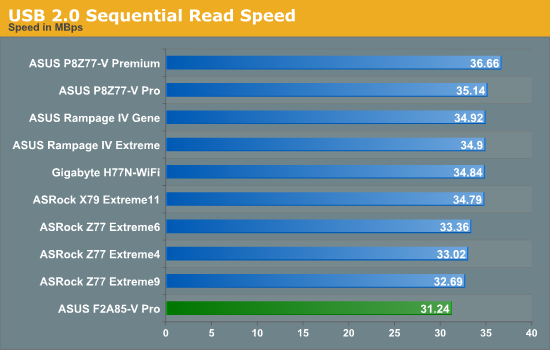
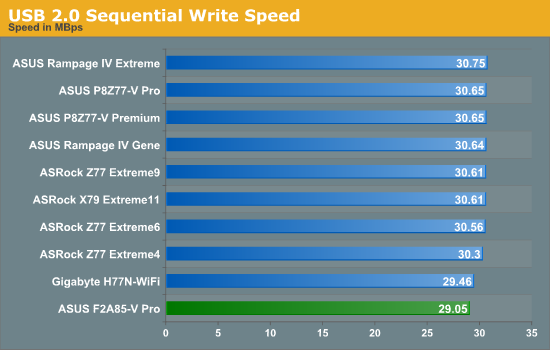
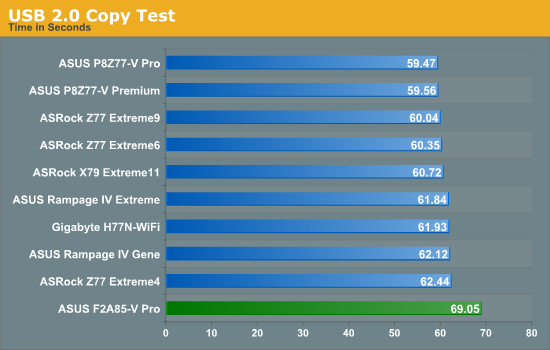
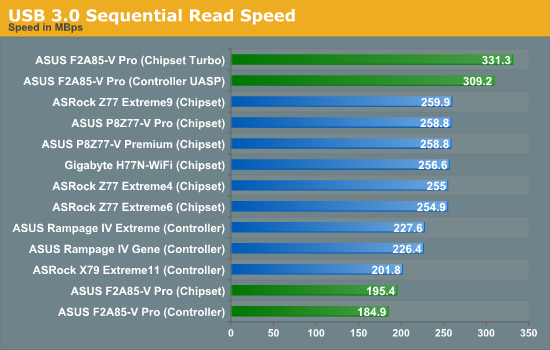
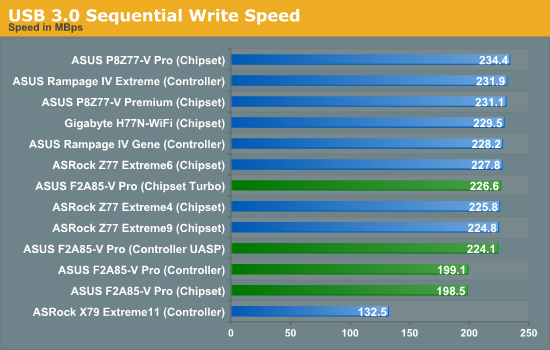
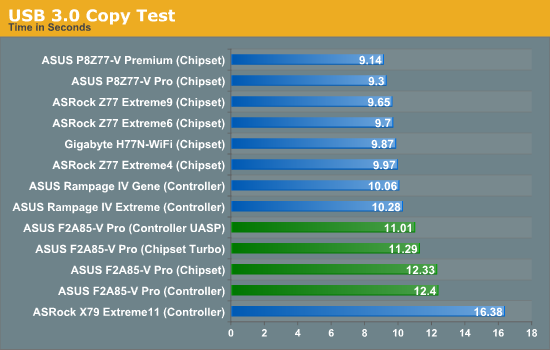
For whatever reason, our standard USB testing regimen on AMD systems shows a slight speed deficiency compared to the Intel systems. In USB 3.0 our copy tests are more than 10% slower on an AMD system.
SATA Testing
We also use CrystalDiskMark for SATA port testing on a C300 drive. The sequential test (incompressible data) is run at the 5 x 1000 MB level. This test probes the efficiency of the data delivery system between the chipset and the drive, or in the case of additional SATA ports provided by a third party controller, the efficiency between the controller, the chipset and the drive.
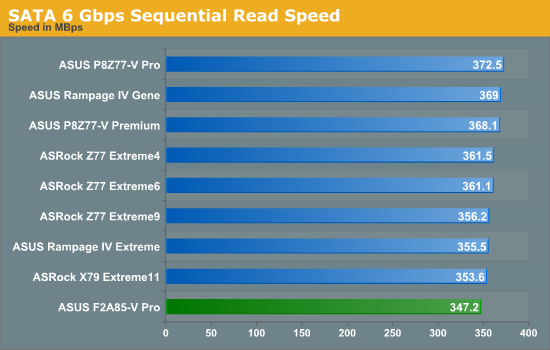
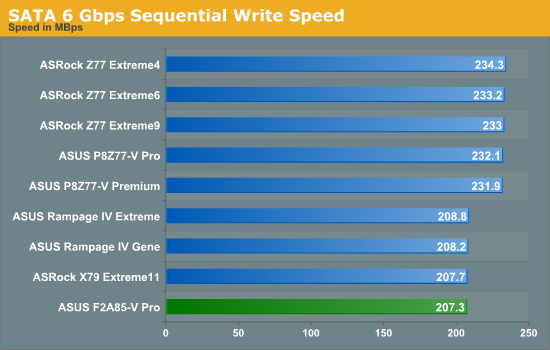
I really like the fact that the AMD chipset is SATA 6 Gbps only, although we see that SATA peak write speeds on this board are slightly lower than that of most Intel boards. Previously this is normally attributed to BIOS settings at default.
DPC Latency
Deferred Procedure Call latency is a way in which Windows handles interrupt servicing. In order to wait for a processor to acknowledge the request, the system will queue all interrupt requests by priority. Critical interrupts will be handled as soon as possible, whereas lesser priority requests, such as audio, will be further down the line. So if the audio device requires data, it will have to wait until the request is processed before the buffer is filled. If the device drivers of higher priority components in a system are poorly implemented, this can cause delays in request scheduling and process time, resulting in an empty audio buffer – this leads to characteristic audible pauses, pops and clicks. Having a bigger buffer and correctly implemented system drivers obviously helps in this regard. The DPC latency checker measures how much time is processing DPCs from driver invocation – the lower the value will result in better audio transfer at smaller buffer sizes. Results are measured in microseconds and taken as the peak latency while cycling through a series of short HD videos - under 500 microseconds usually gets the green light, but the lower the better.

Normally our DPC Latency tests can be affected by monitoring software, producing a value north of 1000 microseconds. Anything under 500 is acceptable, and under 200 is great. However the F2A85-V Pro gets a value in the 600s. During the test, the DPC would hover between 100 and 200 most of the time, but every now and again would peak in the 600 region for whatever reason. The system was rebooted a couple of times but this behavior was persistent across boots. As of the 5104 BIOS this would be slightly worrying for audio work.










66 Comments
View All Comments
andykins - Wednesday, October 10, 2012 - link
A 2500k fits into socket 1155, not 1156 - the latter is Nehalem I believe?Old_Fogie_Late_Bloomer - Wednesday, October 10, 2012 - link
Likewise, the features chart on the first page lists PCIe 3.0 slots...Trinity has PCIe 2.0...IanCutress - Wednesday, October 10, 2012 - link
Apologies - first one was a brain fart, second was carry over. Tables like that I have to write in HTML (via excel) then copy paste in. Somehow got a weird mishmash of the last review and the new one.Ian
Kevin G - Wednesday, October 10, 2012 - link
First page, second paragraph:"Thus if I purchase an i7-3960X today, I know that it will fit into Socket 2011 based motherboards - similarly with the i5-2500K, it will fit into Socket 1156 motherboards. "
The i5-2500K fits into socket 1155.
Anonymous Blowhard - Wednesday, October 10, 2012 - link
> This full sized ATX board is aiming for the enthusiast in the Trinity space> enthusiast in the Trinity space
> enthusiast
> Trinity
Nope
djshortsleeve - Wednesday, October 10, 2012 - link
Well, AMD fanboi enthusiast maybejust4U - Wednesday, October 10, 2012 - link
I am not AMD fanboi but I am a fan of new computer hardware. As such I tend to grab some of the latest stuff. The thing about AMD boards (that I've noticed) is to get something comparable from Intel your usually looking at 30-50 more. Their boards are feature rich at a lower premium.This board in particular, (and Gigabyte's alternative) is over priced. I'd say by 20 bucks. But it's new hardware, slight price premium.. I expect in coming months this board will be 110-120 and the CPU it's paired with will drop to in and around the same price.
CeriseCogburn - Saturday, October 13, 2012 - link
LOL - caught again, and still in public denial.The gaming benchmark page is a shame to the human race and all reporters worldwide, but that's how amd corpo pig pressure rolls.
medi01 - Sunday, October 14, 2012 - link
Do you at least get payed by Intel?Utterly stupid to post so much shit for them for free...
darcotech - Thursday, October 11, 2012 - link
I totally agree.I consider myself more leaning toward AMD,but Trinity has no place in enthusiast world.
It was made as low to medium all-in-one (cheap) solution and as such, it works great.
Why would anyone put mid-high end GPU with trinity is beyond my imagination.
Even if you say you start with Trinity, then add G-card doesn't hold the true, because your CPU performance will suffer.Better start with strong CPU (probably Intel) and basic graphics card, and then later add something much stronger.At the end,you will have strong system.
150USD for Trinity oriented motherboard is not overkill.It is plain stupid.